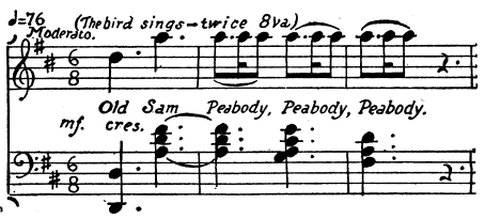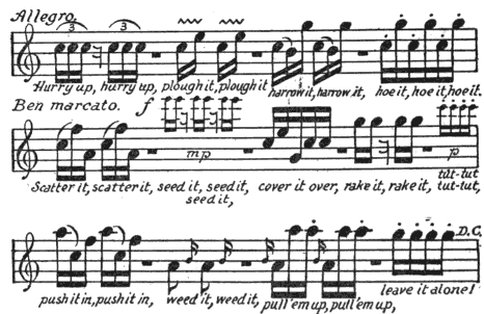Virtuoso Performers
Forest (photo © 2011: Steve Tracey)
I was up early this morning, listening to the dawn chorus. Is anything more emblematic of spring than the singing of birds?
Several people have written to say that they enjoyed the links to bird songs in Friday’s “Liquid Bars of Melody” post. Steve Tracey reports from the Upper Peninsula that he staved off cabin fever all winter by listening to bird songs on his computer and watching the antics of his year-old English setter Forest as he was driven nuts trying to figure out where the birds were hiding. Happy Birthday, Forest.
My friend Mary Ann Linsell wrote to say she particularly enjoyed the white-throated sparrow, with its two-toned song so famously interpreted as “Old Sam Peabody, Peabody, Peabody.” It brings to mind the early 20th century ornithologist and musician F. Schuyler Mathews, who considered phonetic transcriptions of bird song an insult to the birds. He pointed out that the song of the “Peabody-bird” could just as easily be articulated as “Sow wheat Pe-ver-ly, Pe-ver-ly, Pe-ver-ley,” or “All day whit-tl-in’, whit-tl-in’, whit-tl-in’.” The same was true, he said, for every phonetic interpretation of every bird’s song. To correct that imprecision he labored for twenty years to transpose the songs of 127 species into dots on staves, and published them in one of the earliest identification guides to birdsong, Field Book of Wild Birds and Their Music, A Description of the Character and Music of Birds, Intended to Assist in the Identification of Species Common in the United States East of the Rocky Mountains (1904; expanded and reprinted in 1921).

The song of the white-throated sparrow as transcribed by Mathews
[The Cornell Lab of Ornithology's recording of a white-throated sparrow is here]
Although Mathews’s scores can be played on a piano, he insisted that to perform them accurately they must be whistled. It would take a whistling prodigy, however, to do justice to some of those songs. They include dazzlingly complex chords made by birds equipped with twin vocal mechanisms that make it possible for them to sing two notes simultaneously. Also represented are songs composed of cascades of notes—virtual waterfalls of notes—as dense as 64 to the bar. And there are songs to be whistled that we will probably never hear, such as the “strident and insectlike” song of the grasshopper sparrow, which Mathews admits is pitched “so high that 9 out of 10 people can’t hear it singing 30 feet away.”
More recently, ornithologists have counted the music output of certain songbirds and come up with astonishing figures. A red-eyed vireo was once observed singing a two- to four-note song a total of 22,197 times in a 14-hour period. The marsh warbler of Europe, Africa, and Asia spends two months of the year in its breeding grounds from the British Isles to the Ural Mountains of Siberia, then migrates to tropical Africa—a round trip of as much as 4,800 miles. During those long migrations it hears a great variety of songs from other birds, which it faithfully incorporates into a repertoire it puts to work during three to four days of virtually non-stop singing in the spring. A Belgian scientist who spent ten years studying the warbler’s song found that it mimicked as many as 210 other species during each 30-minute burst of song.
A musical prodigy closer to home, and a particular favorite of Gail’s and mine, is the brown thrasher, which should show up any day here in northern Michigan. This large, thrushlike bird has the greatest repertoire of any North American songbird and has been credited with as many as 3,000 melodies. For its performances it likes to take up a position at the top of an aspen, birch, or crab apple in partially open terrain where it can be seen and heard to full advantage. Once you hear its performance you’re not likely to forget it. It strings together jazzlike riffs mimicked from other birds and some of its own invention, and delivers them with ceaseless energy. Mathews noted that the song offers these words of advice to farmers: “Shuck it, shuck it; sow it, sow it; Plough it, plough it; hoe it, hoe it.” Thoreau reported in Walden that the brown thrasher’s “rigmarole, his amateur Paganini performances,” kept farmers company as they planted corn with the constant reminder: “Drop it, drop it, —cover it up, cover it up,—pull it up, pull it up, pull it up.”

The song of the brown thrasher, as transcribed by Mathews
[The Cornell Lab of Ornithology's recording of a brown thrasher is here]
…And Birds on Wires
Finally, while on the subject of birds and musical notation, here’s something strange and wonderful that a friend found on YouTube and sent along:

Jerry, you make me long to hear a marsh sparrow. I recognize very few birdsongs but thrill to them just the same. The first I learned as an adult was that of the song sparrow. After many years, whenever I hear a song sparrow the song carries me back to my garden between Delton and Hickory Corners. I feel the sun on my shoulders and see my cat stalking in the tall grass while my son runs the hose to make puddles to lure the cabbage butterflies. Did birds give music to human beings, do you suppose? Would we have it without them?
Wish I was up in Traverse City! While we do get our fair share of melodious song birds it’s somehow not the same as I remember growing up. I have passed on to our daughter the joy of listing to birds and trying to learn their songs. Our favorite is immitating the cardinal and trying to make them answer your call. I remember my Pop-Pop, my mom’s father, teaching my brother and I in his back yard in East Lansing and what fun we had walking through the woods and listening. We would always try to see if we could accurately immitate the call an answer back. We also had the Peterson Field guide and tried to identify the birds we couldn’t see by their calls. On many summer nights when we were forced to go to sleep while the sun made your room to bright to sleep, I remember listening through my open window to the outside noises. Despite the room being as bright as day, I remember often dozing off to the sound of singing birds (mostly Robins I think but perhaps a Brown Thrasher or two!) that made a long soft song of almost random sounding notes that were all over the scale. It’s pattern was harmonious enough to put me to sleep on many a night. When we lived out by Long Lake my dad once claimed to have identified the “gray catbird” by it’s cat like call. My brother and I never saw it so took him at his word. It is possible our cat at the time, “Sophie” (which my Mom adored but my Dad only tolerated), who was a consumate hunter, wasn’t flattered by the mockery and did the bird in because we never saw or heard the call again. Glad you posted this..it certainly brought back good memories.
P.J. and Andy — Isn’t it interesting how many associations the songs carry for us? And of course the more birds we know, the more and richer the memories that adhere to them. I’m not very accomplished at identifying songs, but I’ve birded with people who are amazing. Most amazing of all was Roger Tory Peterson, with whom I spent an unforgettable day in Central Park in May 1995 (I think). Not only did he know every bird we heard, he could identify songs that were so distant that I couldn’t even hear them.